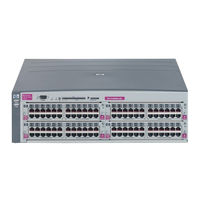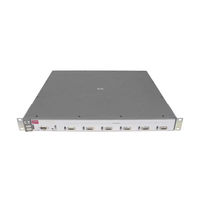
HP ProCurve 5300xl Manuals
Manuals and User Guides for HP ProCurve 5300xl. We have 6 HP ProCurve 5300xl manuals available for free PDF download: Management Manual, Management And Configuration Manual, Access Security Manual, Supplementary Manual, Specification Sheet
HP ProCurve 5300xl Management Manual (664 pages)
Advanced Traffic
Table of Contents
-
Conventions24
-
Overview24
-
Keys26
-
Contents31
-
Overview32
-
Introduction33
-
Terminology35
-
Correct It49
-
Parameters57
-
Preparation76
-
Voice Vlans79
-
Port Trunks82
-
Switches83
-
Overview86
-
Introduction87
-
Overview106
-
IGMP Terms108
-
Contents127
-
Overview128
-
Introduction129
-
Feature Overview130
-
PIM-DM Operation130
-
Terminology135
-
Operating Notes160
-
Troubleshooting162
-
Applicable Rfcs166
-
Contents169
-
Overview170
-
RSTP (802.1W)174
-
Stp (802.1D)174
-
Overview177
-
Configuring RSTP179
-
STP Fast Mode196
-
Terminology199
-
Operating Notes210
-
MSTP Structure213
-
MST Regions215
-
Terminology218
-
Operating Rules220
-
Operating Notes246
-
Troubleshooting246
-
Switch Meshing247
-
-
Contents247
-
Introduction248
-
Terminology250
-
Operating Rules251
-
Preparation257
-
Flooded Traffic264
-
Static Vlans269
-
Dynamic Vlans270
-
Contents275
-
Introduction276
-
Terminology279
-
Overview280
-
Switches290
-
Switches291
-
Switches293
-
No Override297
-
Number299
-
Number300
-
Contents347
-
Introduction349
-
Terminology351
-
Types of IP Acls354
-
Overview354
-
ACL Operation358
-
Introduction358
-
Security363
-
Overview371
-
Types of Acls372
-
Interface377
-
Introduction413
-
Terminology416
-
Overview419
-
Types of IP Acls419
-
ACL Operation422
-
Standard Acls428
-
Extended Acls428
-
Security436
-
Types of Acls445
-
Overview445
Advertisement
HP ProCurve 5300xl Management And Configuration Manual (508 pages)
Brand: HP
|
Category: Network Router
|
Size: 3.59 MB
Table of Contents
-
-
Contents21
-
Overview22
-
Keys24
-
Manager Plus35
-
Plus (PCM+)75
-
-
Interface78
-
Support URL83
-
Port Status87
-
Operating Notes113
-
Connected Host130
-
Sessions140
-
IP Configuration149
-
Configured193
-
Port Mode203
-
Contents219
-
Poe Terminology221
-
PD Support224
-
Contents273
-
Overview274
-
Rate-Limiting275
-
Outbound Traffic283
-
Configuration285
-
Operating Rules288
-
Troubleshooting295
-
Contents297
-
Enabling Snmpv3303
-
Snmpv3 Users304
-
Communities310
-
LLDP Terminology322
-
Cl Switches328
-
Switches330
-
CDP Terminology350
-
CDP Packets361
-
Operating Notes364
-
Contents367
-
Overview368
-
How It Works374
-
Authentication376
-
Workstation378
-
Server386
-
Workstation390
-
Port Status400
-
VLAN Information411
-
Contents421
-
-
HP ProCurve 5300xl Access Security Manual (404 pages)
Table of Contents
-
-
Conventions24
-
Introduction24
-
Keys26
-
Online Help29
-
-
-
Overview36
-
-
-
Clear Button45
-
Reset Button45
-
-
-
Contents55
-
-
-
Introduction57
-
Terminology61
-
-
Contents87
-
-
-
Overview88
-
Terminology95
-
Client Status114
-
Contents115
-
-
-
Overview116
-
Before You Begin122
-
-
Authentication138
-
Operating Notes139
-
Contents141
-
-
-
Overview143
-
Terminology144
-
-
To Protect150
-
-
Services161
-
Terminology167
-
General Steps173
-
Traffic Policies174
-
On the Switch184
-
-
-
Overview204
-
Terminology205
-
-
Behavior217
-
-
-
Overview232
-
Terminology233
-
-
With the CLI240
-
Interface243
-
-
Introduction254
-
Overview254
-
Advertisement
HP ProCurve 5300xl Access Security Manual (292 pages)
Table of Contents
-
Introduction14
-
Overview24
-
Clear Button32
-
Reset Button33
-
Contents43
-
Overview44
-
Terminology50
-
Overview58
-
Overview63
-
Contents71
-
Overview72
-
Contents97
-
Overview98
-
Terminology99
-
Overview128
-
Terminology129
-
Authentication132
-
Authentication149
-
Overview156
-
Terminology157
-
Authentication159
HP ProCurve 5300xl Supplementary Manual (38 pages)
Access Controller xl Module to the HP ProCurve 6400cl/5300xl/3400cl
Brand: HP
|
Category: IP Access Controllers
|
Size: 0.82 MB
Table of Contents
-
Client Vlans15
HP ProCurve 5300xl Specification Sheet (12 pages)
Hewlett-Packard ProCurve Switch Specification Sheet
Advertisement





